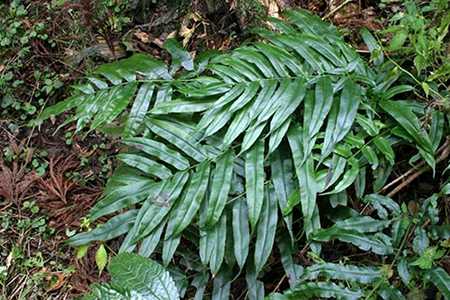Japan is home two miniature spleenwort ferns, Asplenium trichomanes and Asplenium incisum. Both frequent rocky outcrops, with the former preferring moist sites in the shade while the latter is found in brighter places that are on average much drier.
Asplenium trichomanes is a tiny semi-evergreen fern. Throughout the growing season it throws its tiny fronds in a small, loose rosette. Each frond is once pinnate and between 5-10 cm long. The pinnae are slightly lobed, roughly oval in shape, and grow in an alternating pattern down the black, wire-like rachis and average no more than 0.5-1 cm long each. They are a dark blue-green color. The oval sori grow in pairs on opposite sides of the costa. The black stipe is quite short. Both the stipe and rachis are scaleless. It commonly forms large colonies even coating rock faces, but also can be seen in small groups.

This is a truly worldwide fern being found on every continent except Antarctica and even on some Pacific Ocean islands including Hawaii, and is represented by a number of subspecies throughout its impressive range. In Japan it is widespread from north to south. Some subspecies are polyploid (having more chromosomes than the normal compliment), but the Japanese plants are not. This is a fern that grows on rocks or in the cracks of them exclusively. On Kyushu it seems to prefer wet rock faces that are also subject to seasonal drying. It grows from bright to dark shade.
Here is a remarkable little fern. It can be found scattered around almost every temperate climate across the globe as well as some subtropical areas, and even odd places such as the mountains of Yemen and east Africa. In Japan it likes to grow in the company of its own kind and also alongside many other lithophytes including various types of fern, selaginellas, mosses, lichens, and so on.
Despite its delicate appearance, it can withstand drying even to the point of seeming death. It can be found hanging completely desiccated in loose groups of crumpled fronds, however, like many lithophytic and epiphytic ferns, come the next rain its foliage re-hydrates and looks as good as new. Another desirable feature it has is its truly miniature stature. This is one tiny fern, usually not exceeding the breath of a human hand. This one may not be a rarity, but it is a delightful little denizen of Japan’s rocky forests.

The Japanese name for it, chasenshida, is rather whimsical, meaning “tea whisk fern” from the words chasen (“tea whisk”) and shida (“fern”). The overall shape of the fern uprooted looks much like a bamboo whisk used to make macha tea.
A. incisum is very similar in size and form to A. trichomanes. Obvious differences are that the pinnae are strongly lobed, the rachis is green, and the pinnae are a light green color. Each pinna is much more elongated than in A. trichomanes and the variation in size, shape, and spacing along the frond’s length is more pronounced, with the middle blade pinnae being the longest and largest. While the sori grow in an alternating pattern on opposite sides of the costa, they are elongated as well. It is most commonly seen singly or in small groups, but occasionally occurring in larger colonies.
Continue reading “Two miniature spleenwort ferns from Japan, the maidenhair spleenwort and the tiger tail fern”



















